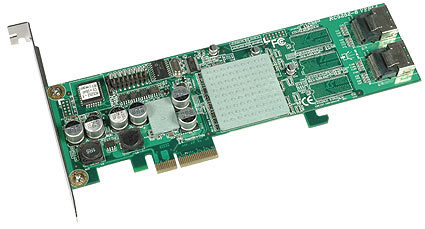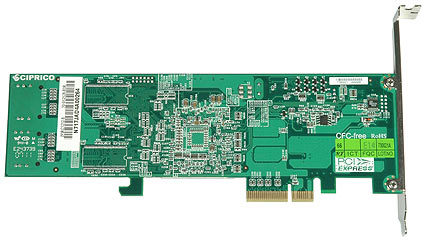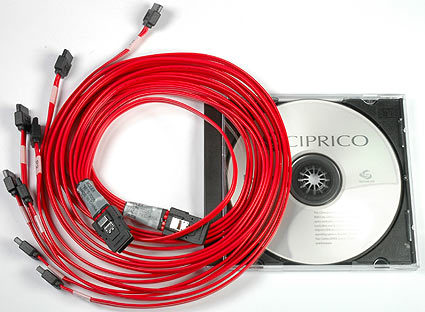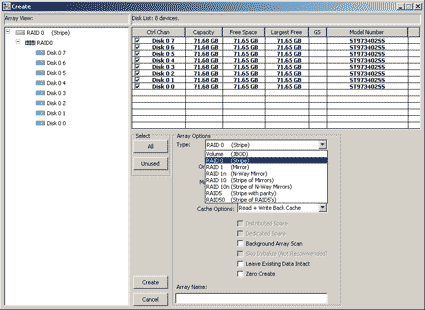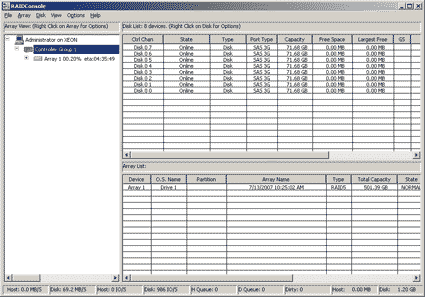Unified Serial RAID Controllers for PCIe
Raidcore RC5252-8
Firmware Version: 3.0.0
Our first contact with Raidcore controllers in 2003 was impressive: the so-called Fulcrum architecture is a host-based RAID solution, which allowed the firm to create mighty RAID controller products that were largely hardware independent. As a result, Raidcore was one of the first storage vendors to offer controller solutions that were capable of spanning RAID arrays across multiple controller cards. This could be done because the logic runs on the host machine. The disadvantage is that all parity calculations have to be offloaded to the host CPU(s), though that is less of a problem these days, as dual and quad core processors are available.
The current Raidcore product is now offered by a company called Ciprico. The RC5000 series has four different models: two low-profile compliant models with four and eight ports, and two full-height cards with 12 and 16 ports. The suffix -8 stands for the port count, 5100 model numbers are based on PCI-X, while 5200 run PCI Express x1 or x4. Ciprico is the only vendor to offer controller spanning, which allows you to create huge RAID arrays across multiple (and even different) Raidcore controllers. The feature list is more comprehensive than what is offered by Adaptec/ICP or Atto, including drive roaming (plug and play drives to any port across any controller), mirror splitting, array hiding, flexible spares (dedicated/global/distributed) and more.
Raidcore does not yet support double redundancy RAID 6 or RAID 60, but it supports RAID 0, 1, 10, JBOD, 5, 50, 1n and 10n. There are drivers for all common Windows versions, Red Hat, Suse and Fedora Linux. Novell Netware, Sun Solaris and other aren’t supported. Ciprico provides a three-year warranty and we found the management software to be pretty straightforward and powerful. The performance of the RC5252-8 was good, though it highly depends on the host system. In our case, our dual processor single core Xeon (Nocona core) at 3.6 GHz was clearly a good choice. Any dual core Xeon 5200 (Woodcrest or Clovertown) will perform better, though.
RAID Array Creation
Get Tom's Hardware's best news and in-depth reviews, straight to your inbox.

Patrick Schmid was the editor-in-chief for Tom's Hardware from 2005 to 2006. He wrote numerous articles on a wide range of hardware topics, including storage, CPUs, and system builds.
-
Rik ...well,Reply
- Unless RaidCore is trying to peddle their VST Pro software,...aka as Fulcrum proprietary based ? which BTW you said no to, I don't see any advantages here.
Why?, ZFS is free !
And, where are the Drives for Solaris, or the xBSD's , or even MacOSX !!!?
-and still no, becuase their newer 54xx series doesn't support the other 'ix OS's.
Nope, unfortunately, not much to see here.
so, based on the above, Adaptec 5805,... or Areca,... blows this.
-Rikster
-
aapocketz ReplyFor SAS, the two connector segments were merged, which makes it possible to attach a SAS drive to a SATA controller using the continuous connector, but you cannot hook up a SAS hard drive to a SATA controller using the SATA connector (SFF 8482).
I think this paragraph has an error. I believe it should read
For SAS, the two connector segments were merged, which makes it possible to attach a SATA drive to a SAS controller using the continuous connector, but you cannot hook up a SAS hard drive to a SATA controller using the SATA connector (SFF 8482).
In fact I believe the statement should have less emphasis on the connector as its the actual controller that appears to limit the connectivity, the connector is just keyed to allow you to plug SATA drives into SAS but not the other way around.
from wikipedia: "SATA 3.0 Gbit/s drives may be connected to SAS backplanes, but SAS drives may not be connected to SATA backplanes."
I believe the fact that signaling voltages are nearly double on a SAS drive is significant to mention.
Let me know if I am wrong, I just started playing around with a bunch of SAS drives so I am figuring this out as I go.
-
Factors like spindle speed, density, latency etc. effects drive performance as much or more than bandwidth. A 300GB 2.5 15K SAS drive will smoke a 1TB 7200 SATA drive simply because it has about twice the IOPS. The bandwidth is meaningless if you can't get the data on and off the disk at the speed of the bus. Furthermore, except for the WD Velociraptor 10K+ spindle speed drives are non-existent in SATA but are prevalent in SAS. So from an interface standpoint they are very close but SAS drives are really intended for entirely different markets and applications and budgets I might add.Reply
-
Bicom Systems Great article - thanks for the comparison! We also did a piece on SAS and SATA, if you're interested : http://blog.bicomsystems.com/sas-vs-sataReply
